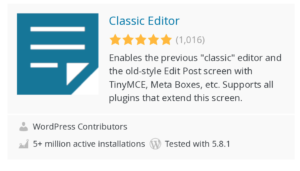Disclosure: This post contains affiliate links. I may receive compensation when you click on links to products in this post. For an explanation of my Advertising Policy, visit this page. Thanks for reading!
I hate WordPress Blocks, what I use instead and FAQs.
Let’s cut to the chase. Here are the reasons why I hate WordPress Blocks and from what I understand, I am not alone:
- Seems like every line of text has to be a separate element with an annoying “pop-up” where you have to decide which block to use, then having to configure thst block which involves even more decisions.
- Complicated to use, illogical, seems to take the fun out of publishing.
- Gutenberg’s uses a terrible interface for just writing and editing text.
- The original and simple WordPress Dashboard is unrecognizable.
- Simple tasks often requires several experimental clicks just to find the elusive thing I want, repeated ad nauseam.
- There are so many *basic* operations that should be dead simple to do, which are either completely unavailable or simply too difficult to either find or to do.
So, if I hate WordPress Blocks so much, what do I use instead? Simple, I use the WordPress Classic Editor. In fact, there are not only a few ways to get back and use the “Classic WordPress Editor” there are even advanced versions.
In this post I am going to go over some FAQs regarding WordPress Blocks, what you can use instead and how to go about restoring your WordPress Editor’s Dashboard back to the original way it looked and functioned, which is why most of us fell in love with WordPress in the first place.
What is Gutenberg in WordPress?
Gutenberg is the official name of the WordPress Block Editor.
What is the WordPress “Classic Editor”?
The WordPress Classic Editor is basically the original WordPress Editor that most of us who had been using WordPress for many years had grown accustomed to and loved. The official name for this Classic WordPress Editor was called the TinyMCE Editor.
Here is what I use instead of WordPress Blocks, the Classic Editor Plugin:
Here are some other plugins you should check out that are related not only to the Classic WordPress Editor, but can actually disable Gutenberg. Although that’s not really necessary since by activating this “Classic Editor” you will by default, deactivate the Gutenberg Block Editor.
I like the Advanced Editor Tools plugin myself, which has features that go beyond those of the “Classic Editor” yet uses the same interface, with just more options to choose from.
How do I get rid of WordPress Blocks?
It’s surprisingly easy to get rid of WordPress Blocks. If you activate the Classic WordPress Editor plugin, the Gutenberg Editor will almost suddenly disappear from your dashboard.
How do I remove Gutenberg from WordPress?
Unfortunately, you cannot remove the Gutenberg Editor from WordPress. It now comes with WordPress automatically by default. Gutenberg is basically built into the WordPress Core and is as much a part of WordPress as your dashboard, header, footer, widgets etc.
How do I turn off Gutenberg?
You can turn Gutenberg off by simply activating another WordPress Editor, the most popular being the Classic WordPress Editor. You activate the Classic WordPress Editor by installing the plugin and activating it. By doing this you will, by default, turn off Gutenberg.
Can I use the WordPress Classic Editor without a plugin?
Yes, you can use the WordPress classic editor without a plugin. How? The WordPress Gutenberg Block Editor actually has a Classic Editor Block built within it.
So, If you don’t want to deactivate Gutenberg nor want to install the Classic WordPress Editor plugin, you can simply only use the Classic WordPress Editor Block whenever you are creating content.
You can basically do everything through the WordPress Classic Editor Block as you could with the WordPress Classic Editor plugin.
I hate WordPress Blocks solution and conclusion.
Hi personally have come to the conclusion that the WordPress Block Editor is simply too hard to use for simple things. Unfortunately though, WordPress insisted on pushing this Block Editor on all it’s users despite the fact that most, if not all, were really satisfied with the Classic WordPress Editor.
It’s seems like Gutenberg was just another example of how “Big Tech” changes something people are already very happy with to something that they ask for or needed and were perfectly content to be without, just for the sake of change.
The good news is that not only are their plugins like “the Classic WordPress Editor” that have answered the call to restore what people loved about WordPress and never asked for their new Block Editor, but there are also improved versions of that very same “Classic WordPress Editor” itself.
They do say that necessity is after all the mother of all inventions.
In addition, if you still want to keep your toes dipped in the “Gutenberg Block Editor”, but still use the “Classic WordPress Editor” for all your publishing, you can since Gutenberg does have, ironically enough, the “Classic WordPress Editor” as a “Block”. There are many people who didn’t disable Gutenberg, but are using that method to avoid having to use Gutenberg.
There are other reasons to hate it: It punishes you when you try to use it. There is also no clear use. Every time you try to learn some basic aspect of it you get punished instead of rewarded.
As a Blogger who is only interested in publishing content, I don’t see how theis WordPress Block Editor could ever be useful to my workflow as publisher.
Let’s face it, bloggers, publishers and WordPress fans were basically forced to used it.
WordPress suddenly changed the editor without giving us a clear choice until you find out that there’s still a Classic WordPress Editor plugin as well as the Classic WordPress Editor Block. It should have been a new feature, not a forced feature when it first came out.
However, I personally am strongly against page builders because of the amount of code bloat they add to display elements. This is why I never uploaded one. Instead WordPress forced this page builder upon me.
In all fairness, if you’re a Developer or a truly advanced user, Gutenberg can give you the ability to build more complex layouts, add functionality and move that functionality around without having develop those at the template level. All without a hodge podge of shortcodes, inline HTML and wrappers.
This also gives those types of users a visible interface and the ability to create your own re-usable blocks, custom code and default settings.
If you’re just a Blogger like me and don’t need all the page building bells and whistles however, 99% of Gutenberg’s Block Editor is useless and confusing.
Therefore, you can either just enable WordPress Classic Editor plugin, or use the Classic Editor Block and add it to your post just like you would without having to deal with the entirety of the WordPress Block Editor and all their Blocks.



